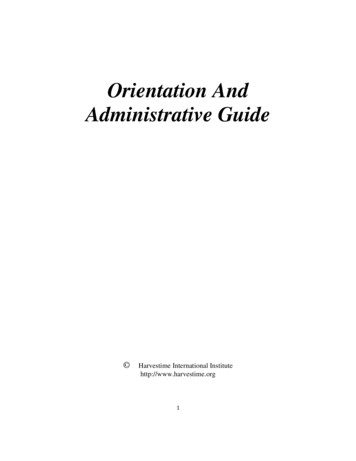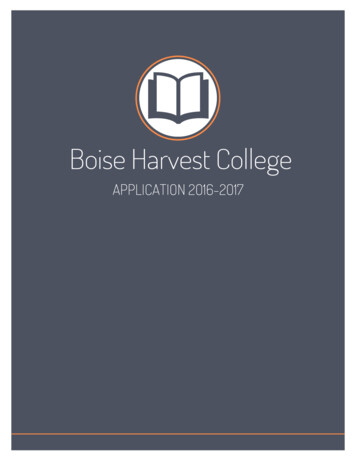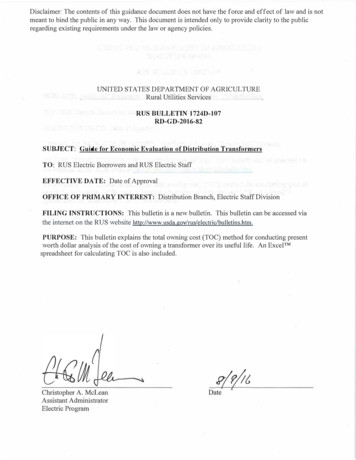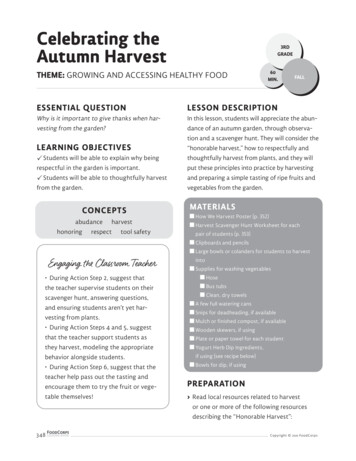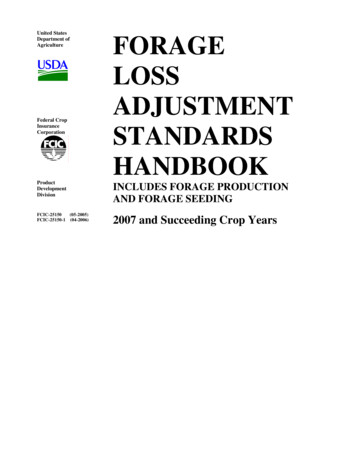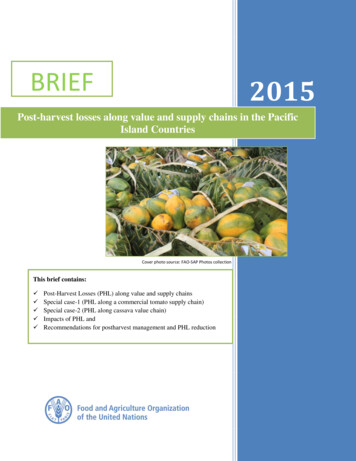
Transcription
BRIEF2015Post-harvest losses along value and supply chains in the PacificIsland CountriesCover photo source: FAO-SAP Photos collectionThis brief contains: Post-Harvest Losses (PHL) along value and supply chainsSpecial case-1 (PHL along a commercial tomato supply chain)Special case-2 (PHL along cassava value chain)Impacts of PHL andRecommendations for postharvest management and PHL reduction0
This brief has been developed by Shukrullah Sherzad (Agribusiness -Junior Professional Officer, FAO-SAP), withcontribution from Tim Martyn (Policy Officer, FAO-SAP)Purpose:This brief focus on four questions:1- When postharvest losses occur in perishable produces’ supply and value chains in the(PICs) 1?2- What are the main causes of postharvest losses along supply and value chains?3- What are the negative impacts of poor post-harvest management and postharvest losses?4- What actions are recommended for the improvement of post-harvest management andpost-harvest losses reduction in the PICs?Post-Harvest Losses along perishable produces’ supply and value chainsAnnual food losses have been estimated around 1.3 billion tonnes around the world2. Theconcept of food losses is defined differently, in developed countries food losses arise at theconsumer stage and concerns food which is processed and ready to eat while in developingcountries food losses occur at the post-harvest stages, during marketing and processing.Postharvest losses (PHL) occur along the entire value chain and vary in extent depending on theproduce and the region.In PICs supply chains of perishable produces for domestic markets are short and farmers, traders,wholesalers and retailers are the key actors. Almost all supply chains’ actors are involved invalue-adding activities. The most common value adding activities are sorting, grading, cleaning,transporting, storage, pre-cooling and packaging.Postharvest losses in produce destined for the domestic market are comparably greater than inproduce destined for export markets. This marked difference is primarily due to postharvestpractices implemented by the farmer, and the leniency of the domestic market 3. Losses incurredon the local market are the result of inappropriate postharvest handling and due to marketsurplus, particular during peak seasons.Table 1: Critical losses points and specifications along generic food value chainBasicelementsSub elementsCritical loss points1Losses specificationsIn this brief PICs are Cook Islands, Federated States of Micronesia, Fiji, Kiribati, Nauru, Niue, Palau, Papua New Guinea,Republic of the Marshall Islands, Samoa, Solomon Islands, Tonga, Tuvalu and Vanuatu2FAO. 2011. Global food losses and food waste extent: causes and prevention3FAO and APO (Asian Productivity Organization). 2005. Postharvest Management of fruit and vegetables in the oks/AG-18 PostHarvest/AG-18 PostHarvest.pdf1
On-farmProductionTransformationTradeFinal sale-cultivate-grow-harvest-dry-poor inputs-rough and untimely harvesting-poor harvesting tools & methods-high day time temperature-classify-process-pack-storage-insects attacks-poor collection centers-limited packaging facilities-poor processing infrastructures-poor worker hygiene practices-poor storage and sanitation system-transport-storage-distribute-sell-poor market infrastructures-limited storages facilities-poor market sanitation-mixed storing-poor transport system-poor produce display centers-poor storages-poor sanitation-specific market-consumption-edible crops leave in field-plough into soil-eat by birds-loss in quality-crop damaged, rodents-spillage, contamination, wilting-process losses-inappropriate packaging damages-losses in quality-compacting-physical damage-microbial infections-spoilage-chilling injury-physical damage-microbial infections-contamination-spoilage-microbial infections-losses in quality-physical damageSource: GIZ (Oguntade.A.E).2013. Food losses in cassava and maize value chains in Nigeria: Analysis andrecommendation for reduction strategies, FAO. 2011. Global food losses and food waste extent: causes andprevention.Unstructured grading and packaging systems; poor infrastructure; poor knowledge of postharvesthandling; high day-time temperatures; limited processing facilities; insect attack; diseases andpoor field sanitation are the main factors contributing in the fruit and vegetable losses in Fiji3.Case study-1-Postharvest horticultural losses along a commercial tomato supply chain in FijiThis case has been studied by the Pacific Agribusiness Research for the Development Initiative(PARDI). In this study tomato producer and retailers are the key actors of commercial tomatoessupply chain from Sigotoka (farm) to Suva (central municipal market) in Fiji. Common valueadding activities such as ripening, sorting, grading, cleaning and transporting are performed bysupply chain’s actors. Due to poor postharvest handling practices and poor infrastructures(collection center, transport and storage) postharvest losses along supply chain (from farmer tovendor) were recorded (32.93) percent. Postharvest losses of tomatoes were recorded (60.78)percent in case of 3days delay in the market place. The removed tomatoes (32.93%) from thecommercial supply chain were used as (11 %) for home and community trade; (6.34%) fordomestic animal feeding and (15.59%) were thrown away.Table 2: Postharvest horticultural losses along a commercial tomato supply chain in FijiTimeLocationProcessLosses %DescriptionDay 1 to 4FarmRipening8.8%Due to rots during ripeningDay 5Farm pack-housePackaging in plastic boxes8.9%Failed to ripen at the time ofpacking2
Day 5TransportTransporting0.13%Day 6MarketSelling6.4%Total losses from (farm to vendor)Distance121.19Km/transported in truckThrown away by vendor dueto over ripe or rots32.93 %Post market losses/wastageDay 7Market8.26 %Day 8Market6.19 %Day 9Market13.4Total postharvest lossesIn case of inappropriatestorage facilities and if notconsume in 3days (72 hours)60.78%Source: PARDI-Pacific Agribusiness Research Development Initiative. (Steven. J.R.U). Not dated. Postharvesthorticultural losses a long a commercial tomato supply chain in Fiji 4.Due to poor postharvest handlingpractices, in both domestic andexport supply chains, farmer sufferedfrom quantitative and qualitativepostharvest losses. Produces such asyam, sweet potato, tomato and avariety of aroids, roots and tubers arehighly perishable and as a result,post-harvestlossescanbe5substantial .Box 1: Impacts of poor post-harvest handling and lossesunsustainable food supply and value chainsincrease in food wastagepoor quality producesdecrease in produce’s shelf-lifeunsafe food products for the customerslimited access to nutrient foodlimited market opportunities and poor prices andlow farm incomeCase study-2- Postharvest losses along a cassava value chain:This study focuses on cassava6 losses during harvesting, processing and marketing stages. Theresult is provided based on survey’s information collected from farmers (200), marketers (30)and processors (55) of cassava in Nigeria. The main stakeholders of cassava’s value chin inNigeria are farmers, agro-processing companies, middlemen, traders and consumers (households,textile industries, pharmaceutical companies, paper and packaging companies etc.). Localfarmers and agro-processing companies produce cassava; farmers, middlemen (mostly women)and agro-processing companies perform post-harvesting handling and processing activities whilemiddlemen (mostly women) and agro-processing companies perform marketing and trading ofcassava in Nigeria.The cassava plant is a relatively new import to the Pacific. Cassava is easy to grow and simple toprepare and is becoming increasingly popular as a food and livestock fodder crop 7. Cassava is4PARDI-Pacific Agribusiness Research Development Initiative (Steven. J.R.U). Not dated. Postharvest horticultural losses along a commercial tomato supply chain in Fiji:5FAO (Keerthi.B.P). 2008. Good practice for assuring the post-harvest quality of exotic tree fruit crops produced in Jamaica6Cassava also known as (maniota in Cook Islands, tapioca or tavioka in Fiji, manioka in Samoa and manioc in Vanuatu)7FAO.2010. Building Resilience to climate change. Pacific Food Security toolkit. Pacific root crops3
processed into gari8 for human consumption and in starch for the food and beverage industries.Cassava leaves are also edible and nutritious. Information of this case study can help cassava’svalue chain stakeholders in the PICs to know more about postharvest losses along cassava valuechain and to be prepared for PHL reduction actions.StageFigure 1: Post-harvest losses in cassava value esthandlingCassava TubersLossesFarm losses 8.51%-Harvest 4.95%-Storage/spoilage 1.63%-Size/small 1.93%PrimaryProcessingMarketingGari, Chips, Starch, FlourGari Processinglosses 14.81%Fresh tubers 12.1%-Transport 2.2%-Too woody 4.1%-Too small 5.8%ConsumptionGari, Starch etc Starch factorylosses 11.8%Gari marketlosses 9.5%Transport 2.5%-Processing 5.5-Storage 6.3%Gari loss 2.71%-Processing 1.6%-Storage/spoilage 1.1%Storage 7.0%-Moisture 4.5%-Rodents 2.5%Source: GIZ (Oguntade.A.E). 2013. Food losses in cassava and maize value chains in Nigeria: Analysis andrecommendation for reduction strategiesCauses of fruits and vegetables postharvest lossesDifferent reasons caused for postharvest losses (PHL) but main causes of fruits and vegetablespost-harvest losses in developing and emerging markets are briefly listed here:Box-2: Top ten causes of fruits and vegetables post-harvest losses in developing countries123456789108poor postharvest handlingpoor packing and packagingpoor infrastructures and connectivitypoor cold chain, transport and climate controlpoor storage facilitiespoor marketing information and pricingpoor education and postharvest research and development (R&D)poor processing capacitypoor investment capacity and credit accesspoor quality standards and controlGari (also known as garri, garry, tapioca) is popular West African food made from cassava tubers4
Source: Wageningen University & Research Centre. 2014. Reducing postharvest food losses in developingeconomies by using a Network of Excellence as an intervention tool9.RecommendationsPostharvest losses reduction are less costly relating to increasing in food production in thePacific region where land and input resources are very limited for agricultural production.Governments, technical universities, value chain’s stakeholders, donors and internationaldevelopment agencies in PICs should work together for postharvest losses reduction in theregion by:I.Strengthening Research and Development (R&D) institutions:(a) research and recommend appropriate agricultural inputs for producing quality produces (b)study perishable agricultural produces within the context of its processing and market potential(c) develop farmers’ friendly maturity indices and recommend appropriate harvest tools andmethods (d) establish grading, sorting and packing protocols for different commodities (e)research and focus on temperature, relative humidity for different commodities under storage.II.Improve access to information and capacity building:(a) capacity building and working directly with farmers, traders and other value chains’stakeholders to accept and promote improved post-harvesting practices (b) capacity building onproper cold chain management (c) encourage simple agro-processing methods in the villages )e)establish regional post-harvest management and losses reduction information networking system.III.Improve on farm post-harvest practices:(a) Improve on-farm hygiene and packing practices (b) support small scale farmers in the basicinfrastructures (packing house, cool storages) development and (c) help producers in valueadding activities.IV.Governments’ policies improvement for PHL reduction:(a) support the development and adaption of applicable postharvest management technologies (b)implement and monitor postharvest management standards (safety, maturity, grading andsorting) for domestic and export markets (c) develop contract farming and linkages amongproducers, processors, and traders (as PPPs) (d) make strong collaboration between producers,governments’ agencies (ministry of agriculture, trade etc.), researchers and donors agencies forestablishing priority projects and (e) increase public awareness campaigns to reduce postharvestlosses in the consumption stages.V.Increase investment to develop infrastructures:(a) build collection centers in the rural areas near production places and equipped with sorting,grading, packaging, sanitation and storage facilities (b) build roads from farms to collectioncenters, storages and market places (c) invest in the processing factories equipped with suitableprocessing technology, good sanitation system, suitable packaging, and appropriate food safetyand quality standards (d) Build market infrastructures and equipped with good storages andsanitation facilities9Wageningen University & Research Centre (L.H. Aramyan.L.H., Van Gogh.J.B). 2014. Reducing postharvest food losses indeveloping economies by using a Network of Excellence as an intervention tool. WU&RC. The /988.pdf5
commercial supply chain were used as (11 %) for home and community trade; (6.34%) for domestic animal feeding and (15.59%) were thrown away. Table 2: Postharvest horticultural losses along a commercial tomato supply chain in Fiji Time Location Process Losses % Description Day 1 to 4 Farm Ripening 8.8% Due to rots during ripening

